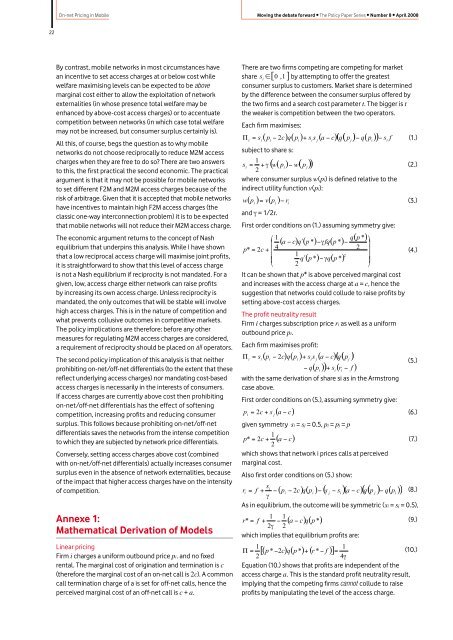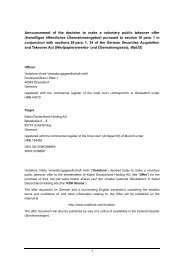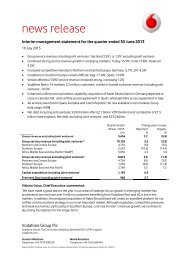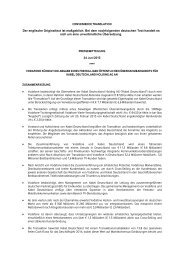Create successful ePaper yourself
Turn your PDF publications into a flip-book with our unique Google optimized e-Paper software.
22<br />
On-net Pricing in Mobile Moving the debate forward • The Policy Paper Series • Number 8 • April 2008<br />
By contrast, mobile networks in most circumstances have<br />
an incentive to set access charges at or below cost while<br />
welfare maximising levels can be expected to be above<br />
marginal cost either to allow the exploitation of network<br />
externalities (in whose presence total welfare may be<br />
enhanced by above-cost access charges) or to accentuate<br />
competition between networks (in which case total welfare<br />
may not be increased, but consumer surplus certainly is).<br />
All this, of course, begs the question as to why mobile<br />
networks do not choose reciprocally to reduce M2M access<br />
charges when they are free to do so? There are two answers<br />
to this, the first practical the second economic. The practical<br />
argument is that it may not be possible for mobile networks<br />
to set different F2M and M2M access charges because of the<br />
risk of arbitrage. Given that it is accepted that mobile networks<br />
have incentives to maintain high F2M access charges (the<br />
classic one-way interconnection problem) it is to be expected<br />
that mobile networks will not reduce their M2M access charge.<br />
The economic argument returns to the concept of Nash<br />
equilibrium that underpins this analysis. While I have shown<br />
that a low reciprocal access charge will maximise joint profits,<br />
it is straightforward to show that this level of access charge<br />
is not a Nash equilibrium if reciprocity is not mandated. For a<br />
given, low, access charge either network can raise profits<br />
by increasing its own access charge. Unless reciprocity is<br />
mandated, the only outcomes that will be stable will involve<br />
high access charges. This is in the nature of competition and<br />
what prevents collusive outcomes in competitive markets.<br />
The policy implications are therefore: before any other<br />
measures for regulating M2M access charges are considered,<br />
a requirement of reciprocity should be placed on all operators.<br />
The second policy implication of this analysis is that neither<br />
prohibiting on-net/off-net differentials (to the extent that these<br />
reflect underlying access charges) nor mandating cost-based<br />
access charges is necessarily in the interests of consumers.<br />
If access charges are currently above cost then prohibiting<br />
on-net/off-net differentials has the effect of softening<br />
competition, increasing profits and reducing consumer<br />
surplus. This follows because prohibiting on-net/off-net<br />
differentials saves the networks from the intense competition<br />
to which they are subjected by network price differentials.<br />
Conversely, setting access charges above cost (combined<br />
with on-net/off-net differentials) actually increases consumer<br />
surplus even in the absence of network externalities, because<br />
of the impact that higher access charges have on the intensity<br />
of competition.<br />
Annexe 1:<br />
Mathematical Derivation of Models<br />
Linear pricing<br />
Firm i charges a uniform outbound price pi. and no fixed<br />
rental. The marginal cost of origination and termination is c<br />
(therefore the marginal cost of an on-net call is 2c). A common<br />
call termination charge of a is set for off-net calls, hence the<br />
perceived marginal cost of an off-net call is c + a.<br />
There are two firms competing are competing for market<br />
share s i ∈[<br />
0 , 1]<br />
by attempting to offer the greatest<br />
consumer surplus to customers. Market share is determined<br />
by the difference between the consumer surplus offered by<br />
the two firms and a search cost parameter t. The bigger is t<br />
the weaker is competition between the two operators.<br />
Each firm maximises:<br />
Π i = si ( pi<br />
− 2 c)<br />
q(<br />
pi)<br />
+ sis<br />
j(<br />
a − c)<br />
( q(<br />
pj)<br />
− q(<br />
pi<br />
) − si<br />
f<br />
subject to share si:<br />
(1.)<br />
1<br />
si = + γ ( w(<br />
pi)<br />
− w(<br />
pj<br />
)<br />
2<br />
where consumer surplus w(pi) is defined relative to the<br />
indirect utility function v(pi):<br />
(2.)<br />
w( pi<br />
) = v(<br />
pi<br />
) − ri<br />
and γ = 1/2t.<br />
(3.)<br />
First order conditions on (1.) assuming symmetry give:<br />
( p * )<br />
( ) ( ) ( )<br />
( ) ( ) ⎟ ⎟⎟⎟<br />
⎛ 1<br />
q<br />
⎜ a − c qʹ<br />
p * −γ<br />
fq p * −<br />
p*<br />
= 2c<br />
+ ⎜ 4<br />
2<br />
⎜ 1<br />
2<br />
⎜ qʹ<br />
p * − γq<br />
p *<br />
⎝ 2<br />
⎞<br />
⎠<br />
(4.)<br />
It can be shown that p* is above perceived marginal cost<br />
and increases with the access charge at a = c, hence the<br />
suggestion that networks could collude to raise profits by<br />
setting above-cost access charges.<br />
The profit neutrality result<br />
Firm i charges subscription price ri as well as a uniform<br />
outbound price pi.<br />
Each firm maximises profit:<br />
Π i = si<br />
( pi<br />
− 2c)<br />
q(<br />
pi<br />
) + sis<br />
j(<br />
a − c)<br />
( q(<br />
pj)<br />
− q(<br />
pi<br />
) + si<br />
( ri<br />
− f )<br />
with the same derivation of share si as in the Armstrong<br />
case above.<br />
First order conditions on (5.), assuming symmetry give:<br />
(5.)<br />
pi = 2 c + s j(<br />
a − c)<br />
given symmetry si = sj = 0.5, pi = pj = p<br />
(6.)<br />
1<br />
p* = 2c<br />
+ ( a − c)<br />
2<br />
which shows that network i prices calls at perceived<br />
marginal cost.<br />
Also first order conditions on (5.) show:<br />
(7.)<br />
si<br />
ri = f + − ( pi<br />
− 2c)<br />
q(<br />
pi<br />
) − ( s j − si)(<br />
a − c)<br />
( q(<br />
p j)<br />
− q(<br />
pi<br />
)<br />
γ<br />
(8.)<br />
As in equilibrium, the outcome will be symmetric (si = sj = 0.5),<br />
1 1<br />
r* = f + − ( a − c)<br />
q(<br />
p * )<br />
2γ<br />
2<br />
which implies that equilibrium profits are:<br />
(9.)<br />
1<br />
1<br />
Π = [ ( p * −2c)<br />
q(<br />
p * ) + ( r * − f ) ] =<br />
2<br />
4γ<br />
Equation (10.) shows that profits are independent of the<br />
(10.)<br />
access charge a. This is the standard profit neutrality result,<br />
implying that the competing firms cannot collude to raise<br />
profits by manipulating the level of the access charge.

















